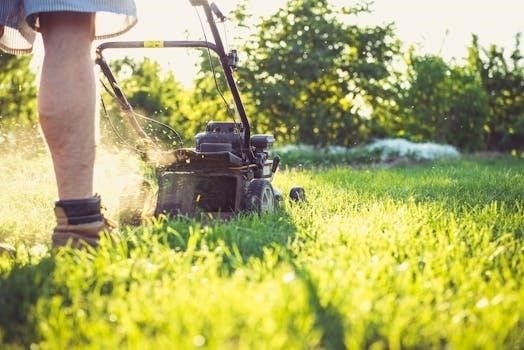Manual Craftsman Self Propelled Lawn Mower⁚ Parts Diagram and Maintenance
Understanding the intricacies of your Craftsman self-propelled lawn mower is essential for proper maintenance. This guide explores parts diagrams, helping you identify components and ensure optimal performance. Let’s delve into the world of lawn mower mechanics!
Understanding Manual Reel Mowers
Manual reel mowers offer an eco-friendly alternative to gas-powered models. Unlike rotary mowers with horizontal blades, reel mowers use a cylindrical blade that spins vertically, cutting grass with a scissor-like action. Their basic design has remained largely unchanged over decades, emphasizing simplicity and reliability.
While gas-powered reel mowers exist, they are often large, tractor-powered vehicles for maintaining sports fields and farms. For home lawns, the manual version provides a quiet, emission-free mowing experience. Understanding their components is key to appreciating their functionality.
These mowers rely on human power to propel the blades and move across the lawn.
Key Components of a Manual Reel Mower
Manual reel mowers consist of several key components working in harmony. The blades and cutting mechanism are central, responsible for the clean scissor-like cut. Wheels and axles provide mobility, allowing the mower to traverse the lawn smoothly. The handle enables the user to push and steer the mower, and often includes height adjustment features.
These parts work together to provide an efficient and environmentally friendly mowing experience. Understanding these components helps in maintenance and repair, ensuring longevity. Each part plays a crucial role in the overall performance of the mower.
Without these parts, there would be no way to cut a lawn.
Blades and Cutting Mechanism
The blades and cutting mechanism are the heart of a manual reel mower. These blades are arranged in a cylindrical shape, spinning to create a precise, scissor-like cut against a stationary bedknife. The sharpness and alignment of the blades are crucial for efficient cutting. Dull blades will tear the grass instead of cutting it cleanly.
Regular maintenance, including sharpening and adjustment, is essential to keep the cutting mechanism in optimal condition. A properly maintained cutting mechanism ensures a healthy and manicured lawn. The bedknife must also be sharp, so the blades can cut against something.
Blades must be set up to operate correctly.
Wheels and Axles
The wheels and axles are fundamental for the manual reel mower’s mobility. The wheels provide the necessary traction to move across the lawn. The axles, acting as the central rotating shafts, connect the wheels to the mower’s frame. These parts must work in harmony for smooth operation.
Proper lubrication of the axles is critical for reducing friction and ensuring effortless movement. Inspect the wheels regularly for wear and tear. Replacing worn wheels maintains consistent cutting height and prevents uneven lawns. The axles must be free of obstruction and not damaged, otherwise the mower will be difficult to push.
Wheel issues can prevent the mower from cutting properly.
Handle and Height Adjustment
The handle provides the user with control and leverage to push the mower. Ergonomic design is important for reducing fatigue during use. The handle’s construction typically involves sturdy materials to withstand constant pressure.
The height adjustment feature allows you to customize the cutting height of the lawn mower to suit different grass types and personal preferences. This mechanism often involves levers or knobs that raise or lower the wheels relative to the cutting blades. Consistent maintenance of the height adjustment mechanism ensures even cuts.
The handle must be securely fastened to the mower frame for safe operation. It is extremely important to read all manuals before use.
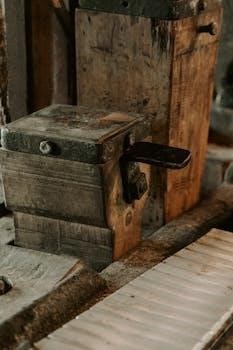
Self-Propelled Lawn Mower Parts
Self-propelled lawn mowers utilize a motor to drive the wheels, reducing user effort. Understanding the parts, from belts to motors, is crucial for maintenance and repairs.
Self-Propelled Unit Versions (GT vs. EGO Chervon)
Craftsman self-propelled mowers sometimes feature different self-propelled units, notably GT (General Transmissions) and EGO Chervon. Identifying your unit is key for sourcing the correct parts. Version A, with a GT unit, often has “General Transmissions” stamped on the black cover. These were often manufactured before May 2019 with a serial number less than NLM08190507851X and have a double-insulated main motor.
Version B employs an EGO Chervon unit, often without a black cover. These are often single-insulated main motor, produced after May 2019, and have a serial number equal to or greater than NLM08190507851X. Knowing the version is crucial for ordering parts for the PCBA and motor.
Identifying Your Self-Propelled Unit
Accurately identifying your self-propelled unit is crucial for sourcing compatible replacement parts. Start by inspecting the unit itself. For Version A, manufactured by GT (General Transmissions), turn the mower upside down and look for the “General Transmissions” stamp on the black cover of the self-propelled unit. This is a definitive identifier for this version.
For Version B, made by EGO Chervon, the self-propelled unit typically lacks a black cover. The manufacturing date and serial number are also helpful indicators. GT models were typically produced before May 2019 with serial numbers less than NLM08190507851X, while EGO Chervon models are often from May 2019 onwards with serial numbers equal or greater to NLM08190507851X.
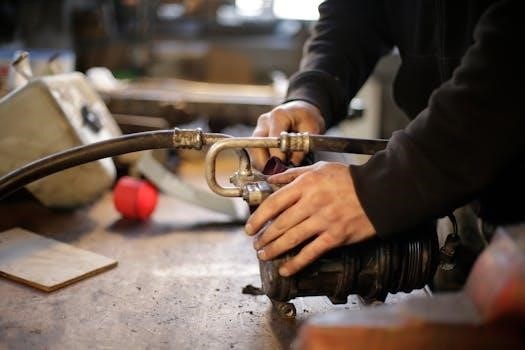
Finding Parts Diagrams
Locating accurate parts diagrams is vital for any repair or maintenance task. Several resources provide detailed diagrams for your Craftsman self-propelled lawn mower. Online parts lookup tools are a convenient starting point. Websites like Sears PartsDirect, Jacks Small Engines, and the official Craftsman website often have interactive diagrams.
These tools allow you to search using your mower’s model number. Inputting the model number will generate a visual representation of your mower, with each component labeled and linked to its corresponding part number.
Additionally, explore online forums and communities dedicated to lawn mower maintenance. These platforms often host shared parts diagrams and expert advice from fellow owners.
Online Parts Lookup Tools
Online parts lookup tools are invaluable resources for identifying and sourcing replacement parts for your Craftsman self-propelled lawn mower. These tools typically feature interactive diagrams that allow you to visually navigate the mower’s components. By clicking on a specific part, you can access its name, part number, and availability.
Many manufacturers and retailers, such as Sears PartsDirect and Jacks Small Engines, offer these tools on their websites. To use them effectively, you’ll need your mower’s model number, which is usually found on a sticker or plate on the mower’s deck or engine. Once you’ve entered the model number, the tool will generate a detailed diagram specific to your mower.
Using Model and Serial Numbers
Accurately identifying your Craftsman self-propelled lawn mower is crucial for obtaining the correct parts diagram and ensuring compatibility with replacement components. The model and serial numbers serve as unique identifiers for your specific mower. These numbers are typically located on a sticker or metal plate affixed to the mower deck, engine, or handle.
The model number provides general information about the mower’s type and features, while the serial number pinpoints the exact production batch and specifications. When using online parts lookup tools or contacting customer support, providing both the model and serial numbers will significantly improve the accuracy of the search.
Maintenance and Repair
Proper maintenance is key to extending the life and ensuring optimal performance of your Craftsman self-propelled lawn mower. Regular maintenance tasks include checking and changing the oil, cleaning or replacing air filters, sharpening or replacing blades, and inspecting belts and cables for wear.
Consult your operator’s manual for specific maintenance schedules and procedures. When performing repairs, always disconnect the spark plug wire to prevent accidental starting. Use the parts diagram to identify and order the correct replacement parts. Troubleshooting common issues can often be resolved with simple adjustments or component replacements, saving time and money.
Finding Your Operator’s Manual
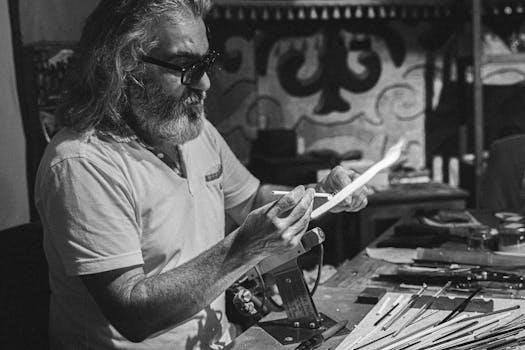
Locating your Craftsman lawn mower’s operator’s manual is crucial for proper maintenance and repair. Often, the manual provides detailed instructions, parts lists, and troubleshooting guides specific to your model.
If you’ve misplaced the original manual, don’t worry! Many manufacturers offer digital versions on their websites. Search by your mower’s model number, which is typically found on a sticker or plate on the mower deck or engine. Websites like Toolservicenet.com allow you to download manuals by entering the model number. A serial number can get you an exact match.
Troubleshooting Common Issues
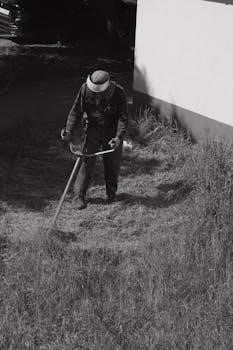
Encountering issues with your self-propelled lawn mower can be frustrating, but many problems have simple solutions. Before seeking professional repair, consider some common troubleshooting steps.
Check the spark plug if the engine fails to start. Ensure it’s clean and properly connected. Examine the fuel lines for blockages and confirm that the fuel is fresh. For self-propelled models, inspect the drive belt and ensure it’s correctly tensioned.
If the mower vibrates excessively, check the blade for damage or imbalance. Consult your operator’s manual for detailed troubleshooting specific to your model. Remember to always disconnect the spark plug before performing any repairs.
